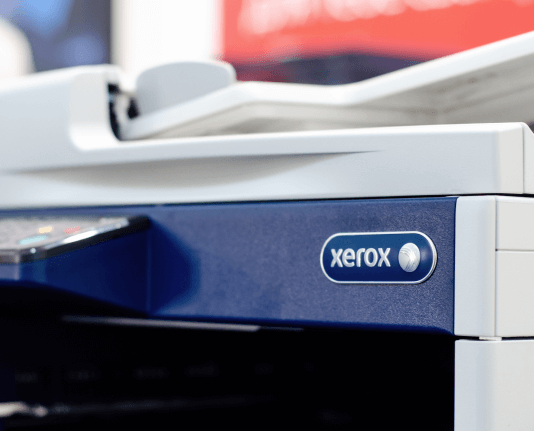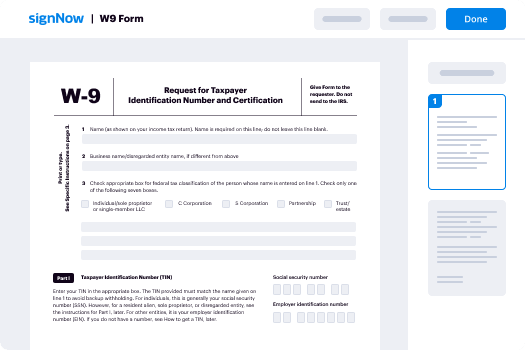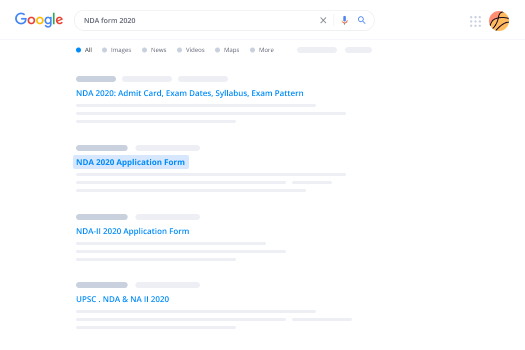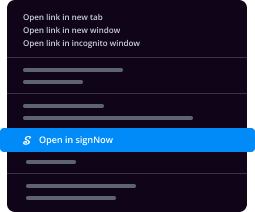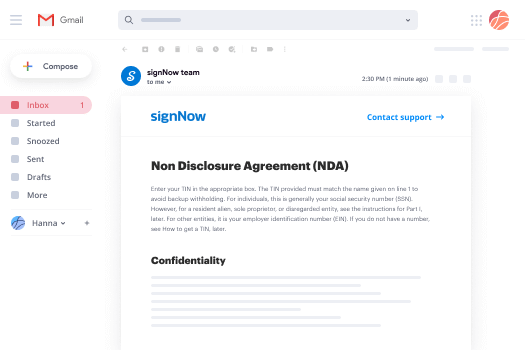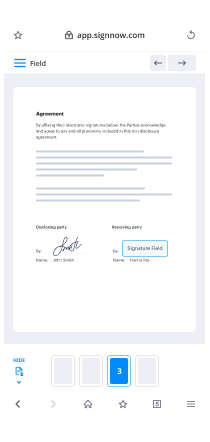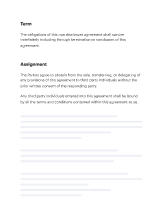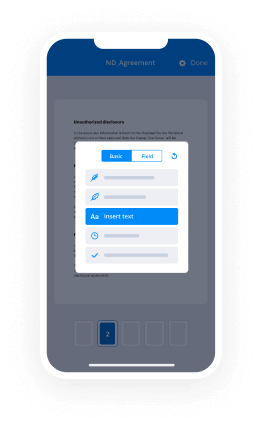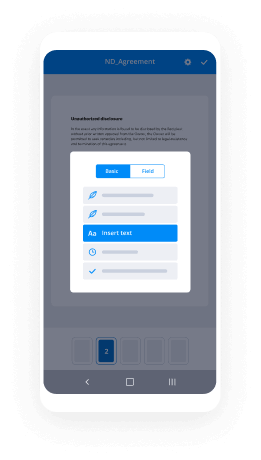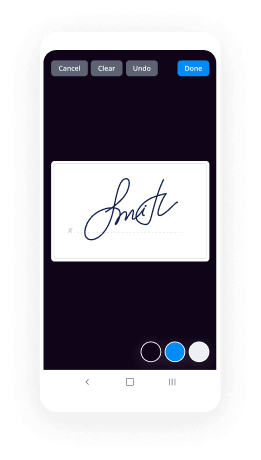eSignature Form for Legal Online
Make the most out of your eSignature workflows with airSlate SignNow
Extensive suite of eSignature tools
Discover the easiest way to eSignature Form for Legal Online with our powerful tools that go beyond eSignature. Sign documents and collect data, signatures, and payments from other parties from a single solution.
Robust integration and API capabilities
Enable the airSlate SignNow API and supercharge your workspace systems with eSignature tools. Streamline data routing and record updates with out-of-the-box integrations.
Advanced security and compliance
Set up your eSignature workflows while staying compliant with major eSignature, data protection, and eCommerce laws. Use airSlate SignNow to make every interaction with a document secure and compliant.
Various collaboration tools
Make communication and interaction within your team more transparent and effective. Accomplish more with minimal efforts on your side and add value to the business.
Enjoyable and stress-free signing experience
Delight your partners and employees with a straightforward way of signing documents. Make document approval flexible and precise.
Extensive support
Explore a range of video tutorials and guides on how to eSignature Form for Legal Online. Get all the help you need from our dedicated support team.
Keep your eSignature workflows on track
Make the signing process more streamlined and uniform
Take control of every aspect of the document execution process. eSign, send out for signature, manage, route, and save your documents in a single secure solution.
Add and collect signatures from anywhere
Let your customers and your team stay connected even when offline. Access airSlate SignNow to eSignature Form for Legal Online from any platform or device: your laptop, mobile phone, or tablet.
Ensure error-free results with reusable templates
Templatize frequently used documents to save time and reduce the risk of common errors when sending out copies for signing.
Stay compliant and secure when eSigning
Use airSlate SignNow to eSignature Form for Legal Online and ensure the integrity and security of your data at every step of the document execution cycle.
Enjoy the ease of setup and onboarding process
Have your eSignature workflow up and running in minutes. Take advantage of numerous detailed guides and tutorials, or contact our dedicated support team to make the most out of the airSlate SignNow functionality.
Benefit from integrations and API for maximum efficiency
Integrate with a rich selection of productivity and data storage tools. Create a more encrypted and seamless signing experience with the airSlate SignNow API.
Collect signatures
24x
faster
Reduce costs by
$30
per document
Save up to
40h
per employee / month
Our user reviews speak for themselves






How to Obtain Form Signature Using airSlate SignNow
If you're looking to optimize your document signing workflow, utilizing airSlate SignNow is a fantastic option. This service enables you to obtain form signatures efficiently while offering an intuitive interface and a variety of powerful tools. With its competitive pricing and strong support, you can improve your business processes effortlessly.
Steps to Obtain Form Signature with airSlate SignNow
- Launch your web browser and go to the airSlate SignNow website.
- Establish a free trial account or sign in if you already have one.
- Choose the document you want to sign or distribute for signatures.
- To reuse documents later, consider transforming them into templates.
- Open your document and make necessary modifications, such as incorporating fillable fields or adding information.
- Insert your signature and allocate signature fields for any recipients.
- Click 'Continue' to set up and distribute an electronic signature request.
To sum up, airSlate SignNow provides an easy and efficient method to obtain form signatures, making it a valuable resource for businesses of any size. Its extensive feature set delivers great value for your investment, ensuring you maximize your signing experience.
Prepared to simplify your document signing workflow? Give airSlate SignNow a try today and enjoy the advantages for yourself!
How it works
Search for get form signature
Familiarize with make form signature
Save the signed document or share it with others
Rate your experience
-
Best ROI. Our customers achieve an average 7x ROI within the first six months.
-
Scales with your use cases. From SMBs to mid-market, airSlate SignNow delivers results for businesses of all sizes.
-
Intuitive UI and API. Sign and send documents from your apps in minutes.
A smarter way to work: —how to industry sign banking integrate
FAQs
-
How can I get form signature using airSlate SignNow?
To get form signature with airSlate SignNow, simply upload your document, add the necessary fields for signatures, and send it to your recipients. They will receive an email notification prompting them to sign your document electronically. The process is quick and user-friendly, ensuring you can get form signature efficiently.
-
What are the pricing options for getting form signature with airSlate SignNow?
airSlate SignNow offers several pricing plans to accommodate different business needs. Whether you are a small startup or a large enterprise, you can choose a plan that allows you to get form signature without breaking the bank. Each plan includes essential features for document management and eSigning.
-
What features does airSlate SignNow offer for getting form signature?
airSlate SignNow provides a range of features designed to make getting form signature seamless. You can create templates, set signing orders, and track document status in real-time. These features enhance your workflow and ensure you can get form signature easily and efficiently.
-
Is airSlate SignNow easy to use for getting form signature?
Yes, airSlate SignNow is designed with user-friendliness in mind, making it easy to get form signature. The intuitive interface allows anyone, regardless of technical skill, to navigate the platform effortlessly. You can start sending documents for signature within minutes!
-
Can I integrate airSlate SignNow with other applications to get form signature?
Absolutely! airSlate SignNow offers integrations with various applications, including Google Drive, Salesforce, and Dropbox, to facilitate your workflow. By integrating these tools, you can streamline your processes and get form signature more conveniently.
-
What benefits can I expect when I get form signature with airSlate SignNow?
When you get form signature using airSlate SignNow, you benefit from increased efficiency, reduced turnaround time, and enhanced security for your documents. The electronic signature process eliminates the need for printing, scanning, and mailing, saving you time and resources.
-
Is it safe to get form signature with airSlate SignNow?
Yes, it is very safe to get form signature with airSlate SignNow. The platform uses advanced encryption and security protocols to protect your documents and personal information. You can trust that your signatures are secure and legally binding.
-
Can NDAs (non-disclosure agreements) be signed through an online form? Are there any legal implications with an online form?
In a word: Yep!Thanks to the E-SIGN Act, documents signed electronically have the same legal protections as those signed with a physical pen! As long as your eSignature solution is committed to strong legality and your NDA is drafted by a professional, you absolutely can trust NDAs that are created, signed, and stored online.There are a few options out there. The rest of these examples are using signNow’s service. You can even create one now with a free signNow account.Here’s how to set up the NDA:Step 1: Acquire an NDA TemplateYou can find NDA templates online, but I would recommend seeking out a legal professional to create one that’s right for your needs.Step 2. Upload the Template, Add SignersAfter signing in to your signNow account, you’ll see the "Who needs to sign?" menu. For a confidentiality agreement, you’ll probably want to choose between “Me & others” or “Just others.” After selecting one, you’ll be able to drag and drop, choose “Add File,” or use any of our integrations to upload your non-disclosure agreement.Now you can add signers, loop in other parties via our CC feature, and assign a signer order if needed. Select “Prepare doc for signing” to move on to the really cool part!Step 3. Format the NDA and Fill in Your InformationWith the NDA you imported pulled up in front of you, click any of the fields across the top of the page and drag it to where you want to place it in the document. Most of the fields have advanced features and some even let you add a validation type (email address, numbers only, etc.) to help guide signers and reduce errors. Take some time to click around to get your NDA dialed in.Once you get your formatting just right, hit Continue at the top of the page. Back on the “Get your document signed” page, you’ll add a title, an optional message, and send your online NDA out for signatures!Step 4. Sign Your NDA Online (Legally and Securely!)If you’re one of the signers, a prompt to sign the non-disclosure agreement will hit your (and other signers’) email inbox as soon as you send it out for signatures. Just click the “Review & Sign” button in the email to continue.We provide a variety of ways to create your electronic signature:Draw your signature on a touch screen using your finger or a stylusUpload a photo of your signatureType in your signature and customize from a selection of fontTake a picture of your signature using your smartphone’s camerasignNow will automatically prompt each signer to complete all their required fields. Once you’ve filled out your portion of the NDA, all you have to do is agree to one last legality measure and your job is done!Step 5. Access Your Online NDA Any TimeTo check the status, edit, or even download a hard copy of your confidentiality agreement; just visit the Documents section of your signNow dashboard any time.
-
Is an e-signature legally valid and treated as valuable as an original signature in the court of law in India?
Everyone knows that India is becoming digital and great initiatives have been taken by our PM. E-Signatures are legally valid in India, and businesses can use it without any doubt.Requirements for validityThe Information Technology Act, 2000 provides for the adoption of e signatures and acknowledges two forms of e-signs as having similar legal acceptance as pen-and-paper signatures. These forms specifically acknowledged under the IT Act include:E signatures which incorporate an Aadhaar ID with an electronic Know-Your-Customer (eKYC) method.Digital signatures which are created by an “asymmetric crypto-system and hash function”. For such signatures, the signer is usually issued a long-term certificate-based digital identity number, stored on a USB token, which is used to place a sign on a document.For the above forms of electronic signatures to be legitimate, they must satisfy these further conditions.The signatory of the e signature must be uniqueAt the point of signing, the signatory should be in control of the data employed to generate the e-sign.Any tamper with the signature, or the form to which the signature is placed, must be easily detectable.There must be an audit trail of procedures followed during the signing process.Signer certificates should only be granted by the signNowing Authority.If all these conditions are followed, then there is an obvious legal belief in favor of the legality of any document signed using e-signatures.However there are some documents which Indian law prohibits to be signed electronically. Here is the list of it.Any document listed by the government of India on the official gazettePower of attorneyTrust deedsA will and other forms of testamentary dispositionNegotiable documents such as bills of exchange, drafts, promissory notes and moreDocuments involving any sale of immovable property such as real estateTo learn more about technical and legal overview of electronic signatures in India, Read this article - Electronic Signatures India - Technical & Legal Overview | signNow
-
Do agreements signed online by EchoSign or signNow have the same legal position as signed by hand?
Online signature software such as EchoSign or signNow use electronic signatures, also known as digital signatures.Most countries now have legislation that provide for the use of electronic signatures.However, these countries may have slightly different requirements for what constitutes a legally binding electronic signature.The United Nations has attempted to provide some unifying features through the UNCITRAL Model Law on Electronic Signatures 2001 but this model law has only been adopted in 32 states including the UK, China, Mexico and India.In the UK, the Electronic Communications Act 2000 was enacted to comply with the UNCITRAL Model Law but it has now been replaced by Europe’s Electronic Identification and Authentication Services Regulation (910/2014/EC)(eIDAS) which came into force on July 1 2016.This new law applies to all EU member states, but since BREXIT, it is uncertain whether the UK will continue with eIDAS.The eIDAS states that only "qualified electronic signatures" will be mutually accepted by all the EU member states. A qualified electronic signature must be uniquely linked to the signer and based on a qualified electronic certificate that is issued by an approved authority.In the USA, the Electronic Signatures in Global and National Commerce Act (ESIGN, 2000) and the Uniform Electronic Transactions Act (UETA, 1999) give similar recognition to online signatures as paper signatures.Under these two acts, the term "electronic signature" means an electronic sound, symbol, or process, attached to or logically associated with a contract or other record and executed or adopted by a person with the intent to sign the record.Briefly, the following requirements must be met for an electronic signature to be valid:The signer intended to sign, consented to the use of electronic records for the transaction and did not withdraw his or her consent.The electronic transaction system must keep a record of how the signature was created or make a textual or graphic statement that must be attached to the agreement.The signer must have received a copy of the UETA consumer consent disclosures.The electronic signature records must be capable of being retained and accurately reproduced later by all parties. In other words, all parties must be allowed to reprint the agreement and the signatures if they want to.In Canada, electronic signatures are governed by the Personal Information Protection and Electronic Documents Act (PIPEDA, 2000). A secure electronic signature must be:Unique to the person signing.The person signing has sole control over the signing process and his or her identify can be verified.The electronic signature is linked to an electronic document in a way that any attempt to change the document can be determined.In general, there's a lot of similarity in requirements governing electronic signatures, mainly because this is necessary to promote the growth of international e-commerce and trading.However, to avoid uncertainty, you should always state in your agreement which country’s law applies to the agreement. If there was going to be a dispute later on, you then know which country’s law will apply to the agreement and what the likely result will be.Also, even though you sign an agreement online using these software, ensure that you print a copy of the agreement and the signatures and keep these paper copies for your own records.For more info, you can check out our article on 4 tools to sign NDA agreements electronically.Credits: Icon "edit" by Chameleon Design from the Noun Project.
-
What are the biggest problems with digital or e-signatures?
[full disclosure: I’m VP Digital Transformation at Solutions Notarius Inc., a company that supplies electronic and digital signature solutions]Great question. I perceive the biggest challenges in relation to electronic and digital signatures to be:Not understanding the function of a signature and therefore what e-signatures are. In the physical world, people intuitively understand what a signature is in its manuscript form, whereas in the electronic world, e-signatures encompass a much wider range of possible forms, from email signature blocks to voice recordings to secured online session date (when you click « I accept ») to images of manuscript signatures to cryptographically protected digital signatures. A signature is a permanent mark that is unique, exclusively used and traceable to a person and affixed on static information with implied or expressed intention. Everything in the electronic world that fulfils that function is a signature.Not understanding that e-signatures are a means to an end / that end is legal reliability. Whenever you are applying a signature to something, especially documents, it is to create evidence of a transaction. The degree to which that evidence will possess the following four reliability attributes will affect the probative value of the evidence: identity (certainty of the identity of signers), integrity (certainty of no undetected changes to document / information signed), authenticity (all that is required to prove identity and longevity is embedded in the document itself) and longevity (document or information signed can be opened, read and authenticated for at least its retention period).Not understanding that there is no such thing as “universally legally valid e-signatures”. People often ask “are electronic signatures legal and are they recognized by courts”? Ascertaining the legality of a form of signature calls for a 4 step analysis, always. First, what is the applicable jurisdiction for a specific or category of information / documents? Some contracts for example include a forum conveniens clause which make applicable the laws of a specific jurisdiction. Second, in that jurisdiction, what are the form requirements for signing those documents? Form requirements may include signing before a Commissioner of oaths and some statutes even prescribe the use of paper (!) in some cases. Third, absent specific form requirements, what is the general default legal regime that governs e-signatures for that type of documents in that jurisdiction? Fourth, is the e-signature solution you plan to use / have used will meet statutory functional requirements? So, in conclusion and from the previous 4 step analysis, it should be clear there cannot possibly be any e-signature solution that is universally legally valid for all types of documents in all jurisdictions.Administrative Adoption. When UNCITRAL e-commerce model laws where adopted worldwide in the period 1998–2008, it created a vexing situation where e-signatures were legal but not administratively adopted. Even if a statute proclaims as a general rule, for example, that “you cannot deprive of legal effect a document that is electronically signed solely on the basis that it is electronic”, administrations such as governments and banks, when they insist on receiving and processing paper documents, are maintaining a barrier to the adoption of e-signatures that e-commerce statutes were supposed to help take down.Not understanding that e-signatures are not all equal when assessing reliability. To assess the reliability of a particular e-signature, one has to assess identity (is the identity of signers reliable? why?), integrity (are changes to the document correctly invaluable dating associated e-signatures? can the original document signed be retrieved notwithstanding changes?), authenticity (is all necessary information to prove identity and integrity embedded in the document - in which case the document is a proof; or not - in which case it is merely a commencement of proof) and longevity (is the document signed and preserved in a logical format - for example ISO 19005 PDF/A with PAdES LTV signatures) - that will ensure it remains readable and verifiable for as long as required?). The word of e-signatures, when it comes to understanding the range of reliability offered - or lack thereof! - is severally lacking in its general knowledge of what makes an e-signature reliable. For example, an signNow Self-Sign certificate that is auto-generated by a user is great for integrity but worthless for identity because the user can declare whatever identity they choose in the certificate.There are other problems and challenges of course but the above are top of mind challenges I see and encounter all the time.
-
What is the best way to get someone's signature ON your website via a form?
If you try signing on a blank document in MS Paint, you'll see its very tricky and sometimes might look totally different than your actual sign. Why not present the user with a challenge and save the answer against the user?
-
How do digital signatures and electronic signatures differ?
Many people think that electronic signatures are the same as digital signatures but that is not the case. In fact, digital signatures are a highly secured way to implement electronic signatures.Digital signatures use a public and private key generation framework, signature algorithm and a verification algorithm to match public and private keys and validate the authenticity of electronic signatures.Ever since the passing of the E-Sign Act in 2000, electronic signatures have acquired as much weight as the traditional wet or ink signature. As a result, electronic signatures have become widely used to conduct business online. This term is quite broad however, and not all electronic signatures constitute as digital signatures, which are guaranteed to fulfill the requirements decreed by the E-Sign Act. These terms include:– The customer’s intent to sign, as well as the consent to sign electronically– The software’s ability to maintain document integrity through unique identifiers– The company’s responsibility to retain all documents for legal purposesWhat does it mean? In a nutshell, every document requiring a digital signature has, in effect, a unique key attached to it. This is done using a public key infrastructure (PKI). Public key is generated & attested by the operator of the PKI called a Certificate Authority, and is held by the document owner, who can then pass on copies to his or her clients. Once the client signs, a unique key (private key) message becomes embedded inside the document. If anyone tries to tamper with the document, the software algorithm will detect it and invalidate the document.Due to increased identity theft in recent years, it has become ever more important for documents to be signed under a watchful eye, whether that be through digital or in-person witnesses. Companies that value your security will enact several layers of protection to ensure that every document is using digital signatures and is legally secure. At signNow, we use industry-standard encryption, time stamps, in-document visibility control, and e-mail authentication to discourage electronic forgery. signNow complies with the E-Sign Act, as well as UETA, HIPAA, and more.
-
E-signing: Is typing your name on a form and clicking submit hold up as a legal signature?
In states which have passed it, the Uniform Electronic Transactions Act (UETA) would govern this. Section 7 of UETA, in particular, specifies: SECTION 7. LEGAL RECOGNITION OF ELECTRONIC RECORDS, ELECTRONIC SIGNATURES, AND ELECTRONIC CONTRACTS. (a) A record or signature may not be denied legal effect or enforceability solely because it is in electronic form. (b) A contract may not be denied legal effect or enforceability solely because an electronic record was used in its formation. (c) If a law requires a record to be in writing, an electronic record satisfies the law. (d) If a law requires a signature, an electronic signature satisfies the law.So, assuming that a signature is required for a contract to be valid, an "electronic signature" suffices. UETA defines "electronic signature" as follows:(8) "Electronic signature" means an electronic sound, symbol, or process attached to or logically associated with a record and executed or adopted by a person with the intent to sign the record.In basic language, this means that when you type out your name and click on the "submit" button, you've electronically signed the record, and the official comments to UETA (not technically law, but extremely persuasive) back this up:This definition includes as an electronic signature the standard webpage click through process. For example, when a person orders goods or services through a vendor's website, the person will be required to provide information as part of a process which will result in receipt of the goods or services. When the customer ultimately gets to the last step and clicks "I agree," the person has adopted the process and has done so with the intent to associate the person with the record of that process. The actual effect of the electronic signature will be determined from all the surrounding circumstances, however, the person adopted a process which the circumstances indicate s/he intended to have the effect of getting the goods/services and being bound to pay for them. The adoption of the process carried the intent to do a legally signNow act, the hallmark of a signature.Although not every state has adopted UETA either in part or in whole without modifications, I believe every state now has similar or identical provisions in its body of law. Assuming that this type of waiver would otherwise be legally enforceable (and many jurisdictions don't allow a waiver of liability for injuries under certain circumstances) then it would not be rendered unenforceable simply because it was signed electronically.Of course, in order to ensure the enforceability of any contract, one should generally consult with an attorney who is familiar with contract law in your jurisdiction and who could recommend a set of best practices for the storage and preservation of any contract stored as an electronic record.
-
When are digital signatures valid, and when are "wet signatures" required? Is there a difference between digital markup on PDF o
For the most part, signatures are not required at all to form a contract, nor are they part of rather legal arrangement between parties. Rather, they are proof that: * the two parties did in fact come to an agreement. Witnesses, communications records, the history of the parties’ acts, and many other things could prove this, but two parties engaging in a formal signing process is much more efficient and conclusive * the two parties intended to be bound to promises they were making each other, and it wasn’t just negotiation, chatter, offers, or statements of intent. Shaking hands, stomping three times on the ground, reciting a prayer, and other demonstrative acts would also work, but in most cases are not an accepted standard, and are harder to implement. * the parties are identified. This goes both to authenticity (the document is real and identity (the parties endorsing it are who they say they are, and are acting on their own behalf or on behalf of a business entity, client, or charge they represent). Other forms of ID, like notaries, witnesses, video records, could work, and documents and signatures can be forged, but a signature, properly authenticated, is simple low cost way to make contracts more trustworthy. Given that a signature isn’t really necessary at all, in principle at least there is not really any difference between a wet signature, a signature via a document service like signNow, a scanned PDF, clicking “I accept”, typing out “/s [signature]”, or any other means. Any requirement is not really based on fundamental principles, but the specific circumstances of the transaction. * Sometimes the parties insist on one particular type of signature before they will do business with each other. Banks and government agencies sometimes insist on a physical signature, or an online signature done through their own in-house system, in order to process a document. You can sometimes fool them with a good digital signature, and they’ll accept the document anyway, in which case no harm no foul. But they’re free to reject it. * Similarly, there may be a custom in a particular realm of business, law, or life. For example, many old school investors only trust wet signatures on paper, thought this is dying out as of the late 2010s. * It could be written into a contract, or an offer, or policy, etc., that only a particular mode of signing is valid. * In a few cases there is a legal requirement to have a wet ink signature, or at least a signature, depending on the specific law. In the United States (and probably many other places) real estate transfers, copyright licenses, wills, and other things require an actual signature. E-signature laws often specify that any kind of signature will do, as a default, unless the law specifically requires one kind of signature or another. There really aren’t any signature standards in the US, just like there’s no standard for how you’re supposed to shake hands or say “I do.” As Europeans like to do, the digital signature standards are much more specific over there. There’s probably an ISO (International Organization for Standardization [ https://www.quora.com/topic/International-Organization-for-Standardization ]) rule for how to wake up, pet your dog, and make coffee in the morning. But the US attitude is whatever does the job will work. FWIW, there is a custom of signing things in blue ink to demonstrate that it is a real signature. Red or green would do but they look a little silly on a contract. Thus, when I apply a digital signature to things I usually make it blue.
Trusted esignature solution— what our customers are saying
be ready to get more
Get legally-binding signatures now!
Related searches to eSignature Form for Legal Online
Free document signing online
E signature online
Online forms with signature free
Sign documents online free Google
Document sign online
How to create e signature in Word
Free e signature
Digital signature software free
Frequently asked questions
How do i add an electronic signature to a word document?
When a client enters information (such as a password) into the online form on , the information is encrypted so the client cannot see it. An authorized representative for the client, called a "Doe Representative," must enter the information into the "Signature" field to complete the signature.
How to make an electronic signature from a scan?
The only place I found information about this was in the State University's "Electronic Security (CEC) Course". It is not a prerequisite, so the only thing you need to do is read the entire class description and then just start working on getting the software, which is freely released, on your phone. If you are a student with an iPhone, just scroll to Chapter 3 and start doing stuff. There are a lot of cool apps for this.
Why is it a big deal to have an "electronic signature" on my files?
In the world of digital signatures, it is the most important thing.
For an image, you do this by signing it with an image signature.
What is an image signature?
You can imagine your document as a digital signature, but it's made by signing an image with an image.
This method is used by the federal government when they print out documents and when they scan documents to keep them in digital form. In general, any digital information, from your passport to a document in the state DMV, is an image signature.
So, let's say that I have a document I scanned that says "The State of New York Department of Transportation" and I want people to know that it is an actual document that contains my name, my signature, and my image. How do I do this?
You can use an image signature on your scanned document.
If you don't have an image to use, you can use "Digital signature" to use the same image. You just need to sign off using your name, your signature, and the image on your document.
So, ho...
How to proconnect esign married filing jointly?
How to get joint tax return? Read more
The new version of the US tax code includes a tax on all US residents' international travel to countries that do not tax such activity. The bill, which is scheduled for a floor vote soon, imposes a 10% levy on those who travel to or spend time in countries with which the US does not have a tax treaty.
The idea is to get money, which is now going out of the country to lower-tax countries, back into the US. But a group of US Senators and representatives, as well as the US Treasury Department's top foreign tax policy official, think this move is a terrible idea for two reasons.
First, they say a 10% tax in a country that doesn't charge an equivalent tax doesn't raise much money.
The Treasury Department's deputy assistant secretary for international tax affairs has told Congress that the tax, which could hit people traveling to New York for a weekend of Broadway shows, would raise less than $30m a year.
The money would go to reducing the US corporate tax rate which is one of the lowest in the world.
"There's no doubt the 10% tax is something that is being talked about and there will be a debate on it," said David Wilkins, senior economist with the Tax Foundation , "but it's not going to be the kind of conversation most are expecting to have."
Mr Bratton is more convinced. In 2014 he wrote a study for the American Enterprise Institute, a right-wing think-tank, arguing that the 10% tax would raise $500m a year.
The US already has a si...
Get more for eSignature Form for Legal Online
Find out other eSignature Form for Legal Online
- Heshethey executed the same form
- County state of south dakota and described as follows form
- State of south dakota and being described as follows form
- Deed of trust fill out and sign printable pdf template form
- And the board of directors of a south form
- Sd inc cr form
- The south dakota business corporation act south dakota codified laws title 47 form
- Officer personally appeared known to me or satisfactorily proven to form
- Incorporated and principal place form
- Sellers agent if any form
- Bill of sale form mississippi sublease agreement form
- Contact the governors office state of south dakota form
- Information on change of name adult
- South dakota legal formslegal documentsus legal forms
- Return to south dakota secretary of state form
- Sdlrc codified law 15 26a sd legislature form
- State of south dakota in circuit court ss 490219195 form
- Sdlrc codified law 23a a sd legislature form
- Ss county of clay in circuit court judicial circuit form
- South dakota fixed rate note installment payments secured by personal property form

